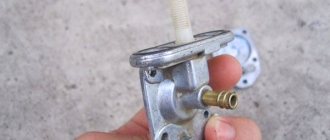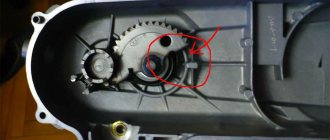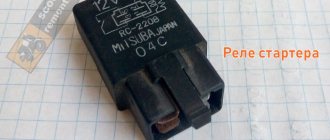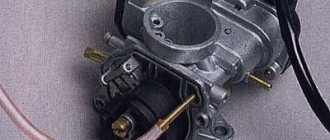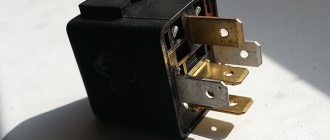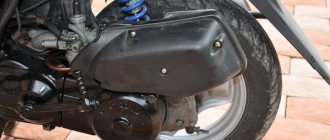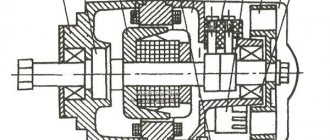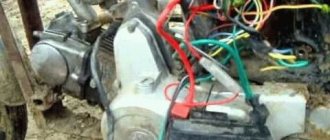Today, not only an experienced adult, but also a beginning child rider can ride an ATV. For little fidgets and lovers of active leisure on wheels, a huge number of models are offered - from small and compact to quite “adult” and powerful, with large engines and impressive parameters. Therefore, buying an ATV for children is not a problem.
The design of such models exactly replicates full-fledged ATVs for large ones. Moreover, a children's quad also requires periodic maintenance and replacement of consumables. And breakdowns on such four-wheelers may not be “childish” or “toy-like” at all. We'll tell you what to do if there is no spark on your child's ATV.
What to do if there is no spark on a children's ATV?
If the vehicle engine does not want to start, then the first objects of research are the fuel system and the ignition system. You need to check if there is any spark in the spark plug. The algorithm of actions is basically the same, both for a full-fledged ATV and for a child’s one. And if you understand that there is no spark on the children's ATV, then you need to act in approximately this order:
- We check the functionality of the spark plug. To do this, you need to unscrew the spark plug and clean it from carbon deposits. Then we insert the end of the spark plug into the cap and touch the engine with the second edge and turn on the ignition so that the crankshaft turns. If the candle is flooded and wet, it must be dried and calcined at high temperatures. Better yet, replace it with a new, working one.
- After this, we check the electrical wiring, paying special attention to soldering points and possible oxides on the contacts. Eliminate all damage to the winding, remove traces of oxidation of the contacts, and carefully solder all connection points.
- After this, you need to make sure that the ignition coil is working properly. To do this, use a multimeter and check the resistance at the coil contacts.
- If your child has a four-stroke ATV, the next step is to check the commutator. If this part is faulty or causes you doubts, it is better to immediately replace the entire unit, since it cannot be repaired.
- The last step is to measure the resistance on the generator. If the readings are not normal, the problem lies in the pulse sensor or in the generator winding.
If you perform all the steps consistently and carefully, the breakdown will most likely be found and fixed. And the ATV will start up quickly and rush your child along the road or rough terrain. But it also happens that the specified algorithm of actions does not help, and there is still no spark on the children's ATV. What to do in this case?
Causes of ATV breakdowns and troubleshooting
No starter after turning the key
- The shut-off valve is closed: open it or set it to the “reserve” position. There is old and/or contaminated fuel in the tank: empty the float chambers (the small screw at the bottom of them), check if necessary if they are dirty and add new fuel.
- The fuel vacuum valve does not open: remove the hose from it and crank the engine. If fuel is not flowing, the vacuum diaphragm at the valve or the vacuum suction line is likely to blame. Turn the tap to the PRI or Reserve position.
- Clogged fuel tap pipe or filter: Remove the pipe from the tap and check if fuel flows when you open it. If so, the secondary fuel filter is clogged and needs to be replaced. If not, remove and clean the faucet.
- Flooded engine: Remove the spark plugs and dry them, close the fuel valve, turn off the lights if you can. Turn the throttle fully and engage the starter - the spark plugs should be on the wires and on the engine. Don't touch the candles. Put them on and start the engine.
Where else to look for the reason for the lack of spark?
So, the spark has disappeared on the children's ATV, and you have ruled out faulty wiring or the ignition system. What to do next? The next diagnostic objects will be the fuel supply system. The fact is that with proper and timely fuel supply, even a weak or irregular spark can ensure normal engine operation. And since there is no spark on the ATV and it is motionless, it means that you need to check what kind of fuel is coming from the fuel tank to the combustion chamber. You can find out more about the gasoline recommended for a quadric from the salon consultants https://dvako.com.ua.
For this:
- clean the filters - both the fuel supply and the air supply;
- check the integrity of the hoses and tubes through which the fuel mixture is supplied;
- make sure that the carburetor vent is open, and also that the seal in the carburetor itself is not broken;
- you need to set the correct position of the needle that regulates the fuel supply.
Inspecting and troubleshooting the entire fuel system will help resolve the problem. And in the future, change the spark plugs on time, clean the filter and fill the gas tank with only good fuel. And your child will always be able to ride a fast and maneuverable ATV “with a breeze”! And you won’t remember such a problem as the loss of spark on a child’s ATV.
The ATV will not start: looking for a fault
22.10.2015
ATV won't start? Don't know where to start troubleshooting? Then let's try to find out the main reasons why an ATV may refuse to start.
Unfortunately, equipment from any manufacturer sooner or later begins to act up, no one is immune from this, but finding a fault and starting an ATV that refuses to start is not so easy, especially if you are far from a service station.
No matter how trivial it may sound, the first thing you need to do is check the presence of gasoline in the gas tank: believe me, very often a person tries to start an ATV with a dry tank.
Look to see if the engine power button is turned off; it is usually located on the left side of the steering wheel, and also pay attention to the fuses, perhaps one of them has blown.
The ATV will not start: reason No. 1
Next, take a multimeter and measure the charge level of the ATV battery: a charged battery should produce from 12.6 to 12.8 volts and confidently turn the starter, but if the battery is discharged, charge it.
It is also necessary to pay attention to the battery terminals; they must be clean and not oxidized, and the clamping bolts must be tightened.
If, when trying to start the ATV, you notice that the starter does not turn, you must first check and, if necessary, replace the starter relay. To check whether the starter itself is working, you need to make sure that the engine mass is in good condition (oxides, lack of contact, damage to the wire) and apply positive to it directly from the battery (observing the polarity); if the starter spins, look for a problem in the wiring. If there is no response to your actions, most likely the starter has failed.
Check the condition of the spark plug and the presence of a spark. This is roughly what a spark plug looks like when installed in a serviceable and tuned engine:
The ATV will not start: reason No. 2
If you notice a significant change in spark plug color, your ATV carburetor may need to be adjusted.
In order to check for the presence of a spark, you need to unscrew the spark plug, insert it into the spark plug cap, lean it against any metal part of the ATV (don’t forget about safety precautions: there should be no gasoline leaks nearby) and turn the starter, the spark should be confident and clearly visible. If there is no spark, you need to replace the spark plug; if a spark does not appear, check the wiring, and also replace the ignition coil.
Make sure your ATV's air filter is clean and saturated and that the air pipe from the filter to the carburetor is not damaged or clogged.
Determine whether fuel is entering the carburetor, whether the fuel filter is clean, whether the fuel pipes are intact, clean the carburetor using cleaning fluids and purging the channels.
The ATV will not start: reason No. 3
Determine whether the fuel pump is working properly. After turning on the ignition, you should hear the sound of the fuel pump turning on and gasoline being pumped into the fuel system. It is also necessary to check the functionality of the fuel pump relay.
The ATV will not start: reason No. 4
A very common cause of poor engine starting is a worn piston and, as a result, poor compression (as a rule, this applies to ATVs with decent mileage); compression can be measured with a special device called a compression meter.
The ATV will not start: reason No. 5
Quite often, an ATV has trouble starting in the winter, but there is a set of measures that make starting an ATV much easier; you can find out about them by following the link.
Here are, perhaps, the most common malfunctions, in the presence of which the ATV will not start. We hope that the provided manual was useful to you, and finally we invite you to watch a video that shows how to properly start an ATV with a manual starter, because it is not as simple as it seems at first glance.
Source
The engine is low-powered and consumes a lot of gasoline
- Air filter dirty, air intake system clogged: clean / replace the filter. Make sure that all air intake openings are not blocked and that air flows freely into the engine.
- Ignition or electrical system failure: Make sure the battery is charged and properly connected, the ignition contacts are dry and the wiring is good.
- Voltage in the ignition system is too low: charge the battery, check the condition of all connections, remove rust.
- Faulty spark plugs: check the condition of the spark plugs; Check the gap between the electrodes, adjust if necessary, screw in new spark plugs.
The engine does not work and overheats
- The mixture is too lean due to clogged carburetor nozzles: drain all gasoline from the tank, disassemble the carburetor and clean it, refill with fresh gasoline.
- The mixture is too lean due to incorrectly adjusted carburetors or injectors: adjust the carburetors.
- Carburetor traps left air: Carburetor is not installed correctly/tightened, intake manifolds are cracked or porous.
- Pinched, jammed or kinked fuel line: check its condition along its entire length.
- Oil level too low: add oil as needed.
- Oil pump malfunction or oil circuit clogged: Stop the engine immediately and contact a workshop.
What needs to be done to improve the situation? There is a screw at the bottom of the carburetor that screws in horizontally (the guide can serve as a return pipe with a fitting next to it). This screw must be unscrewed to allow the old gasoline to drain out. The liquid will be cloudy and yellowish. Once it turns into clean gas, the fuel must be drained. To do this, just tighten the screw.
Now you can try to run the quad: most likely there will be no problems. Therefore, before leaving the ATV in the garage for any period of time, you need to drain the gasoline remaining in the carburetor. Upon return, it is filled with fresh fuel, so you can continue driving the ATV with peace of mind.
The ATV stalls: The engine starts hard, chokes, runs erratically and stalls often
- Dirty fuel, rust in the tank, dirt in the fuel lines, in the carburetor: drain the gasoline, clean the tank and carburetor, pour a fresh bottle.
- Idle speed is too low: increase it using the speed control knob.
- Fuel tank vent is clogged: Clean the vent hole (in the plug) or the vent tube at the outlet of the engine.
- Stuck choke line or lever causing engine to run too rich: Remove and clean this item.
- Due to damage to the carburetor nozzles, the engine sucks in left air: tighten the rubber nozzles and check for cracks.
- The battery is too weak: charge it, check all connections, remove tarnished cables, replace spark plugs if necessary, check ignition pipes or cables.
- Incorrect gap between the electrodes or ground connection to the spark plug: check the type of spark plugs and their condition, set the distance between the electrodes, replace the spark plugs if necessary.
- Broken/broken wire or ignition coil/spark plug tube connector, incorrectly installed tube: Pull out or unscrew the ignition wire, cut a small piece and reinstall/screw in again. Make sure the tube is not rusted and the hoses are installed correctly. The engine starts reluctantly and there is little power at low speeds.
- Incorrect valve clearance, worn valve levers; Broken valve springs or worn camshafts: Check valve clearances and adjust them correctly, assess the wear condition of valve clearance adjustment bolts, valve springs and camshafts.
- Burnt out valve seats, worn valve guides, stuck valves: check compression.
- Damaged cylinder head gasket, bent or cracked cylinder head: check the cylinder head for oil leaks, pay attention to the color of the exhaust gases. On a liquid cooled engine, white indicates head gasket damage.

